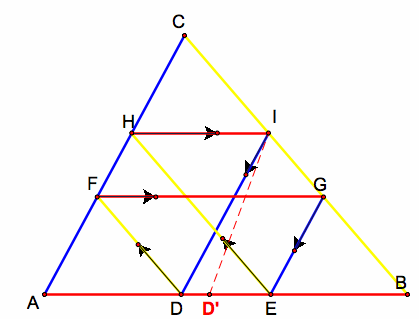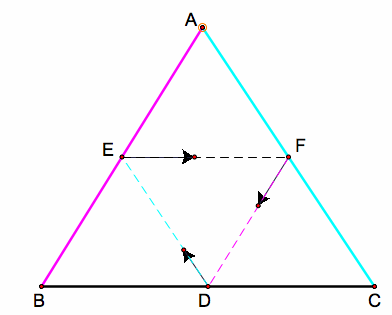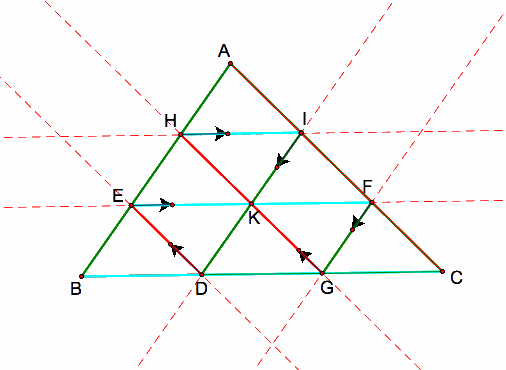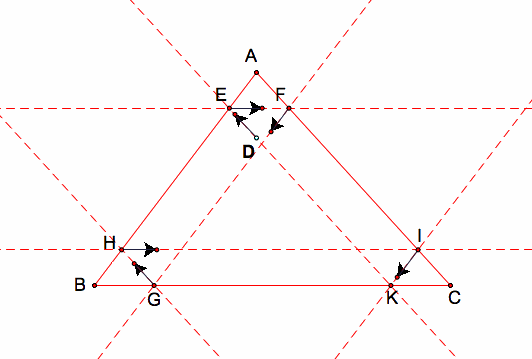

Final Assignment (PART 1): Bouncing Barney
Ebru Ersari
Barney is in the triangular room ABC. He walks from a point on BC parallel to AC. When he reaches AB, he turns and walks parallel to BC. When he reaches AC, he turns and walks parallel to AB. Prove that Barney will eventually return to his starting point. How many times will Barney reach a wall before returning to his starting point? Explore and discuss for various starting points on line BC, including points exterior to segment BC. Discuss and prove any mathematical conjectures you find in the situation.
First, let us prove that Barney will eventually return to his starting point. I will prove this by assuming that Barney started form the point D and returned to the different point, point D’.

First Part: We know that AC // ID’ // EG, HI // FG // AB, and DF // EH // BC. Then, ∡BAC =∡BD’I.
Second Part: We need to also show that ∡BAC=∡BDI. For this, we will look at ∆HAE and ∆IDB.
HE // IB and HI // BE, thus EBHI is a parallelogram and HE = IB.
FG // AE and AF // GE, thus AEGF is a parallelogram and FG = AE.
FG // DB and DF // BG, thus BDFG is a parallelogram and FG = BD.
Since FG = AE and FG = DB, then AE = DB.
Also, we already know ∡AEH = DBI.
HE = IB, AE = DB, and ∡AEH =∡DBI. From Side-Angle-Side congruency, ∆AEH and ∆DBI are congruent triangles. For that reason, ∡EAH =∡BDI.
From the first and second part of the proof, we got AC // DI (from ∡BAC =∡BD’I.) and AC // DI (from, ∡EAH =∡BDI).Finally we got AC // DI // D’I. There is only one parallel line passing through one point. It means that D and D’ are the same points.
We have proved that Barney will eventually return to his starting point. Now, let us explore how many times Barney will reach a wall before returning to his starting point for different cases.
If Barney starts at the midpoint of side BC, here is the route of his way:

Since ED // AF and AE // DF, AEDF is a parallelogram. From the property of parallelogram, opposite sides of a parallelogram are equal in length. Thus, ED = AF.
Since ED // CF and EF // CD, CDEF is a parallelogram. From the property of parallelogram, opposite sides of a parallelogram are equal in length. Thus, ED = CF.
From the two equations ED = AF and ED = CF, we get AF = CF. (It means that F divided AC into two equal parts as AF and CF).
Since EF // BD and DF // BE, BDEF is a parallelogram. From the property of parallelogram, opposite sides of a parallelogram are equal in length. Thus, EF = BD.
Since EF // CD and ED // CF, CDEF is a parallelogram. From the property of parallelogram, opposite sides of a parallelogram are equal in length. Thus, EF = CD.
From the equations EF = BD and EF = CD, we get BD = CD. (It means that D divided BC into two equal parts as BD and CD which we already know).
Since DF // AE and DE // AF, AEDF is a parallelogram. From the property of parallelogram, opposite sides of a parallelogram are equal in length. Thus, DF = AE.
Since DF // EB and EF // BD, BDEF is a parallelogram. From the property of parallelogram, opposite sides of a parallelogram are equal in length. Thus, DF = EB.
From the equations DF = AE and DF = EB, we get AE = EB. (It means that E divided AB into two equal parts as AE and EB).
When we compare the perimeter of triangle ABC and DEF;
AB + AC + BC = AE + EB + BD + CD + CF + AF
We have already found that AE = DF, EB = DF, BD = EF, CD = EF, CF = DE, AF = DE. By applying this equations,
AB + AC + BC = DF + DF + EF + EF + DE + DE
AB + AC + BC =2 DF + 2 EF + 2 DE
AB + AC + BC = 2 (DF+ EF + DE)
The perimeter of the triangle DEF is one-half of the perimeter of triangle ABC.
If Barney starts at one-third of the segment BC, here is the graph of the route:

HI // EF // BC.
FG // DI // AB.
ED // GH // AC.
Since DE // FC and EF //DC, CDEF is a parallelogram. From the property of parallelogram, opposite sides of a parallelogram are equal in length. Thus, ED = CF.
Since DE // AI and DI //AE, AEDI is a parallelogram. From the property of parallelogram, opposite sides of a parallelogram are equal in length. Thus, ED = AI.
Since triangle BDE and BCA are proportional because of AAA similarity, AC = 3 ED.
AC = AI + IF + CF and we have already found that ED = CF and ED = AI. By applying these equations into the first one,
AC= ED + IF + ED
AC = 2 ED + IF
Since AC = 3 ED and AC = 2 ED + IF,
3ED = 2 ED + IF
3ED - 2ED = 2ED + IF -2ED
ED = IF
We have found AI = IF = FC = ED.
Similarly, when we do the same process for other points E, F, H and I,
BE = EH = AH and BD = DG = CG.
Triangle AHI and AEF are similar from SAS, and
AH / AE=AI / AF=HI / EF = 1 / 2
Thus, EF = 2 HI.
Triangle BDE and BCA are similar from SAS, and
BD / BG=BE / BH=DE / GH = 1 / 2
Thus, GH = 2 DE.
Triangle CFG and CID are similar from SAS, and
CF / CI = CG / CD = FG / ID =1 / 2
Thus, ID = 2 FG.
Similarly, by using SAS similar triangle properties,
AB = 3FG (Triangle CFG and CAB are similar triangles).
BC = 3 HI (Triangle AHI and ABC are similar triangles).
AC = 3 DE (Triangle EBD and ABC are similar triangles).
The total lenght of Barney’s route is ED + EF + FG + GH + HI + DI. When we compare this route with the triangle ABC,
AB + AC+ BC = 3(DE + FG + HI)
ED + EF + FG + GH + HI + DI = (ED+ GH) + (HI + EF) + (FG + DI)
ED + EF + FG + GH + HI + DI = (ED + 2ED) + (HI + 2HI) + (FG + 2FG)
ED + EF + FG + GH + HI + DI = 3(DE + HI + FG)
ED + EF + FG + GH + HI + DI = AB + AC + BC
If Barney starts at one-third of the segment BC, the total length of the way he walked is same as the perimeter of triangle ABC.
If Barney starts inside of triangle ABC, here is the graph of his way:

The total length of his way is DE + EF + FG + GH + HI + IK + KD. Let us compare this length with the perimeter of triangle ABC.
Since IK // HB and HI //BK, BHIK is a parallelogram. From the property of parallelogram, opposite sides of a parallelogram are equal in length. Thus, IK = BH.
HA = FG from AFGH parallelogram.
GH = AF from AFGH parallelogram.
FC = EK from CFEK parallelogram.
KC= EF from EFCK parallelogram.
BK = HI from BHIK parallelogram.
AB + AC + BC = BH + HA+ AF + FC + KC + BK
AB + AC + BC = IK + FG + GH + EK + EF + HI
The total length of Barney’s way is DE + EF + FG + GH + HI + IK + KD and
DE + KD =EK. Thus, the total length of Barney’s way and the perimeter of triangle ABC are equal.
If Barney starts outside of triangle ABC, here is the graph of his way:
